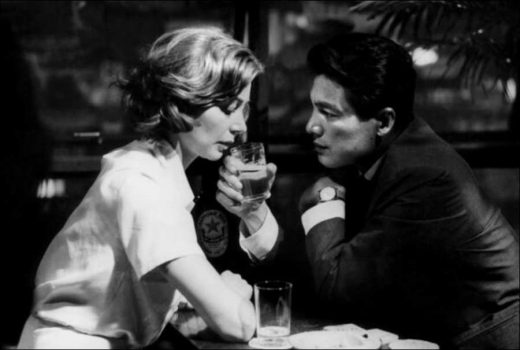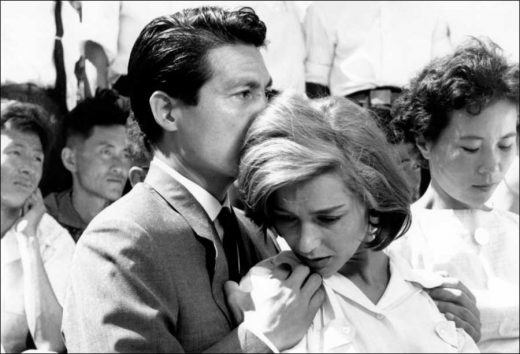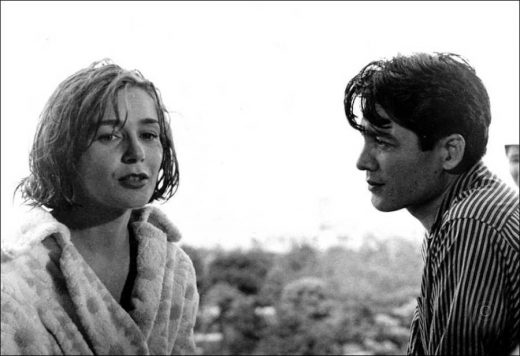Hiroshima Mon Amour movie review. Following the success of Alain Resnais’s film Night and Fog (Nuit et brouillard, 1956), which radically changed the representation regimes about the massacres in the Nazi camps, his production company, Argos Film, encouraged the director to shoot a new film while preserving his documentary approach.
This time, the subject of the feature-length film will be the effect of the atomic bomb on Japan. While contemplating the project with his close friend and colleague Chris Marker, Resnais came to the conclusion that there were many successful documentaries about the tragedy in Japan and that a documentary film to be shot after them would have nothing to say.

How interesting it is that today’s cinema writers and thinkers encounter a similar impossibility in the face of Resnais and Hiroshima mon amour (1959), who turned to fiction as a result of a creative impossibility and played a major role in changing the narrative language of modern cinema. Perhaps it is possible to transform impossibility into the main object of creation by asking what we have to say when there are so many analyses, articles and books written about Hiroshima My Love.
Another name that made the emergence of Hiroshima My Love possible is Marguerite Duras. After it was decided that the film would be fiction rather than a documentary, leading literary figures such as Françoise Sagan and Simone de Beauvoir were considered to write the script, but Resnais’s path crossed with Marguerite Duras at the turning point of her cinema career. Duras and Resnais agree from the very beginning that the story will not be directly about the atomic bomb, but the destruction it creates will inevitably be felt in the background.
Hiroshima Mon Amour tells the story of a short-lived love affair that blossoms between a French woman and a Japanese man who come to Hiroshima to star in a movie. Thus, this relationship, which looks like a one-night stand from the outside, actually carries the weight of social, historical and psychological burdens dating back ten years. The Loire River in the French woman’s hometown of Nevers branches out and meets the Ôta River in Hiroshima. The remnants of the tragic love she had with a German soldier in the shadow of the Second World War are revealed in the facial features of the Japanese man.
Seeing and Touching
Resnais and Duras’ narrative seems to be under the influence of some kind of gravitational force. Like the French woman and the Japanese man, like the Japanese man and the German soldier, like Nevers and Hiroshima, past and present inevitably converge. We see this rapprochement materialize in the image of bodies hugging tightly after the credits.
The layers of meaning they carry separate one by one. These two bodies are marked by the droplets of sweat left behind by passion and passion, the dust left over from the ruins of the war, and the radioactive radiation of the bomb, which the Japanese at that time called “picadon”, that is, luminous explosion. Just like the bodies petrified by the eruption of Vesuvius in Pompeii, Resnais’s camera seals the bodies with the light of the picado.
Eternal Now
In films such as Night and Fog and Hiroshima My Love, shot after the Second World War, the feeling that history stopped in Auschwitz and Hiroshima and that the future cannot even be imagined is very dominant. Yet, whether we want it or not, historical time has passed outside the parentheses, other horrors have opened and closed other parentheses.
What does Resnais’s approach to archive images mean in the world of digital images, where the archive is renewed and disappears moment by moment? Because the eyes of humanity, which saw everything but nothing in Hiroshima, are more open than ever and more blind than ever. How naive and nostalgic the dystopian and even post-apocalyptic framework that Hiroshima My Love drew when it was released appears to our eyes today.
When we look at it from today, the helplessness and critical distance brought by accepting that the apocalypse has come and nothing worse will happen from now on is not a naive approach. Although Hiroshima My Love is a film ahead of its time, it does not seem possible to make films with this historical awareness in 2023, and even if they are, it is inevitable that they will be condemned to an empty, outdated formalism. Unfortunately, there is no room for place and time, yesterday, today, Hiroshima, Nevers in the digital image regime. Because this parenthesis in which we are trapped has grown and expanded in a way that cannot be closed, and has turned into an eternal present where bombs explode every second.
Hiroshima Mon Amour (1959)
Directed by: Alain Resnais
Starring: Emmanuelle Riva, Eiji Okada, Stella Dassas, Pierre Barbaud, Bernard Fresson
Screenplay by: Marguerite Duras
Production Design by: Sacha Kamenka, Takeo Shirakawa
Cinematography by: Michio Takahashi, Sacha Vierny
Film Editing by: Jasmine Chasney, Henri Colpi, Anne Sarraute
Costume Design by: Gerard Collery
Makeup Department: Alexandre Marcus, Éliane Marcus
Music by: Georges Delerue, Giovanni Fusco
MPAA Rating: None.
Distributed by: Pathé Films
Release Date: June 10, 1959
Views: 368














